Perichoux farm
Agroecology, diversity of crops, soil fertility, compost, crop associations, mulching
Damien Martin, Sathurnin Bossou
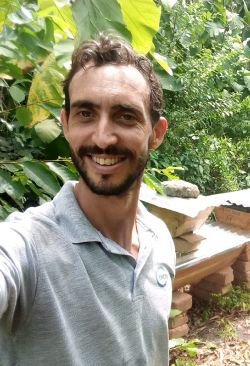
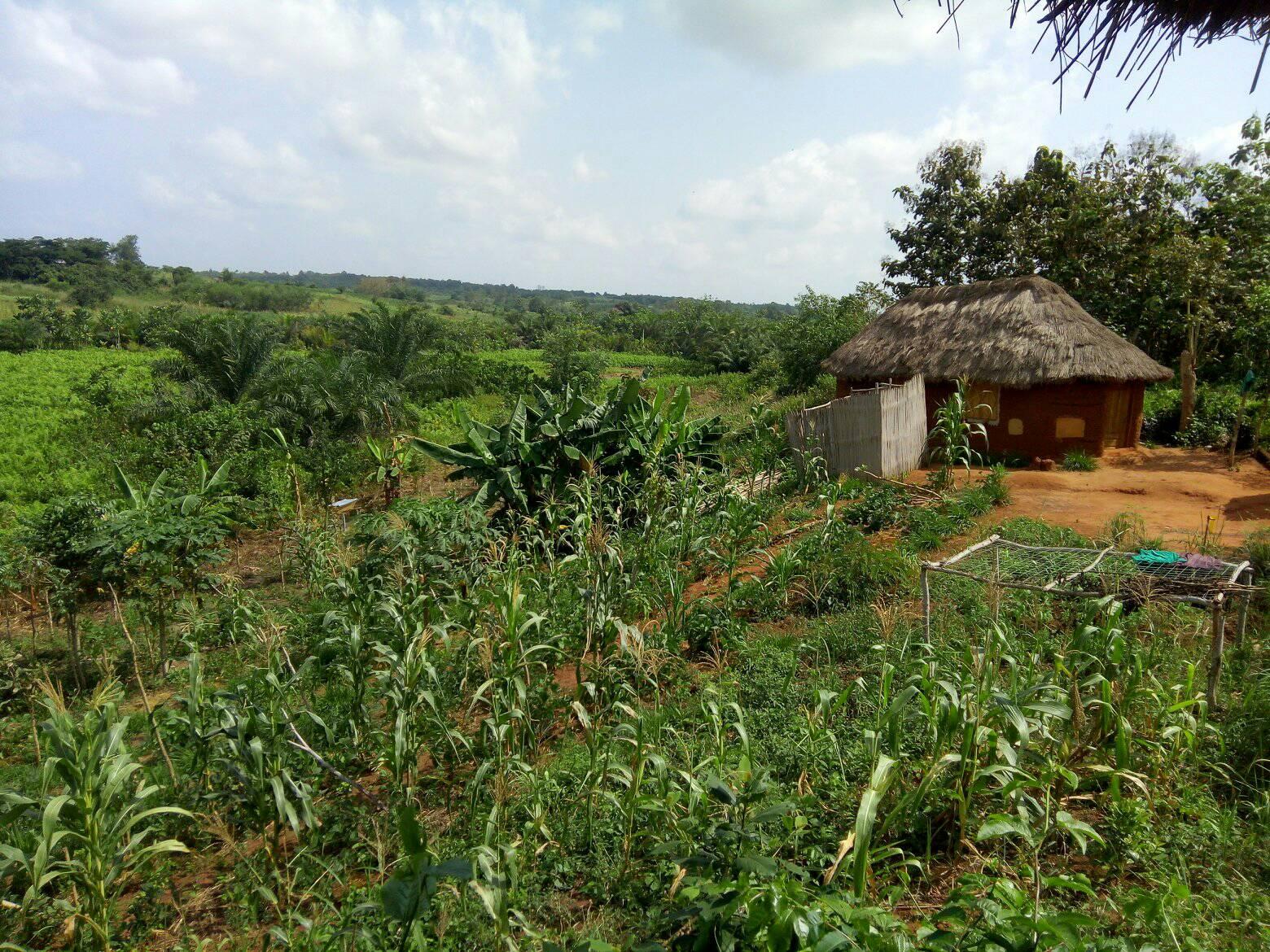
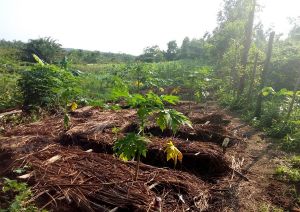
Damien Martin, a farmer in Koudjanada, Benin, cultivates his land according to agroecological principles. He is supported by several employees, including Sathurnin Bossou. Here is the profile of their farm.
Context
The farm
- Farmer's name: Damien Martin.
- Farm's name: Perichoux farm.
- Location: Koudjanada, Zè, Benin.
- Establishment date: 2016, Sathurnin joined as an employee in 2022.
- Cultivated area: 1.25 hectares.
- Soil texture: Sandy-loamy.
- Number of people working on the farm (Full-time equivalent): 4.
- Climate: 1200 mm of rainfall per year in 2023. According to the Köppen-Geiger classification, the climate is of type Aw. There are significant wind gusts before storms, creating a venturi effect, which can bend the corn.
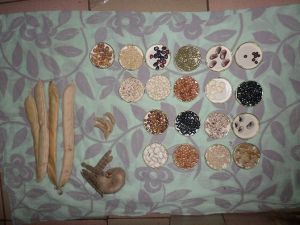
Plant productions
A variety of vegetable crops (mainly for self-consumption): 20 species of fruits, vegetables, and herbs including: Peppers (bird, Antillean, long pepper), lettuce (a "classic" variety and a variety of lettuce similar to a local dandelion: yantoto, which multiplies by runners. Known locally but rarely used in salads, this plant does not need to be re-sown and bolts much slower than classic lettuce, thus having strong nutritional and agronomic value for the agroecosystem), tomatoes, okra, turmeric, ginger, eggplant (white and purple), cucumber, climbing beans (various varieties: pink, black, bicolor, white seeds. The beans are associated with fruit trees as supports and as a secondary production of the fruit trees). Occasionally, they also plant carrots and beets.
- Food crops: 15 species: Beans (varieties listed above), cassava, yam (several varieties), sweet potato, maize, soybean, taro, pineapple, watermelon.
- Fruit trees: 40 different species:
- Local varieties: Baobab, tamarind, velvet tamarind, star apple, wild apple, nere, twin banana, miracle fruit (endemic to Togo, Benin), egbe (local name), oil palm, banana (6 varieties: 2 plantains and 4 sweet bananas), sapodilla, jujube, egg tree.
- Exotic varieties: Goïne vine, passion fruit, avocado, coconut, lychee, longan, rambutan, guava, papaya, mango, soursop, custard apple, pepper, jackfruit, citrus (lemon, orange, grapefruit), cashew, kola nut (several local and exotic varieties), Calabar nut, palm nut, coffee, cocoa.
- Medicinal plants: Over 100 species, many plants that grow spontaneously have medicinal properties. Among the most "remarkable" or used, they include: Artemisia afra (for malaria treatment), red pea, neem, caïlcédrat (Senegal mahogany), African hyssop (Newbouldia laevis), moringa, and other herbs used for animals.
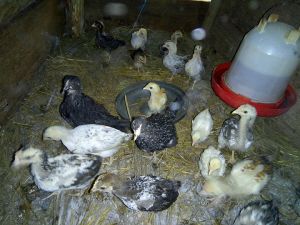
Animal productions
- Poultry production: They encountered health issues at the end of last year (2023) which reduced the flock, but the goal is to have breeding stock to ensure self-consumption of part of the animal production and to sell a few individuals if the predation pressure is not too high. They want the agroecosystem to be able to support the animal load instead of developing a large-scale poultry production operation.
- Local poultry: 20.
- Turkeys: 4-5.
- Guinea fowls: 4-5.
- Ducks: 4-5.
- Small ruminant and other animal productions:
- Goats, sheep: 10 (3 breeding stock for goats and the same for sheep.)
- Guinea pigs: 10.
- Gambian rats: 4.
- Beekeeping: 4 species of local bees, 6 hives. Following a fatal accident on the farm related to a bee attack, the decision was made to drastically reduce beekeeping activity and to raise meliponines, stingless bees, instead of the European bee species usually kept for honey production.
- Snails: Production in the open field, in enclosures. Production for self-consumption, in the experimental phase. Damien and his team started captive breeding conventionally, but it required a lot of time, and the rapid multiplication of snails caused overcrowding in the enclosures. They released the snails into an uncultivated field and will harvest them at the end of the two rainy seasons. After the harvest, they will perform a general weighing and keep 10% to reintroduce into the field. The idea is to utilize uncultivated spaces like fallows, hedges, etc. There is currently no impact on food crops from this type of "semi-natural" management. This form of breeding requires little work. At the end of this year's rainy season, they will conduct the first harvest.
Studies/Education/Life path
- Damien Martin: Holds a BTS in aquaculture. He arrived in Benin in 2003 and has been cultivating his land since 2016. His mother is a researcher at INRAe, working on surface water themes, and she trained him in organic gardening. His father was a farm worker who passed away from generalized cancer, which led Damien to develop an aversion to chemicals and a desire to grow vegetables without using pesticides.
- Sathurnin Bossou: Is the son of a farmer, he studied literature before gradually moving closer to the agricultural world. He learned agriculture through practice, and his knowledge is empirical. Sathurnin was the teacher of Damien's daughters, and they discovered a mutual interest in agroecology, leading Damien to train him in these practices. Sathurnin has a reflective approach to agroecology inherent to the peasant agricultural world around him, and he participates in and leads agroecological volunteer days and awareness campaigns.
Motivations and objectives
- Damien: His main goal is to sustain his farm. He aims to demonstrate the value of this type of agroecological farming, creating an agro-system that allows for significant and economically viable food production that can be replicated by a family of 5-6 people. The farm's objective is to focus on self-consumption. The sale of farm products only occurs if there are surpluses.
- Sathurnin: His goal is to demonstrate the interest and multiple benefits of implementing agroecological practices, which is why he also applies them in his own half-hectare field.
Perichoux farm also aims to train new generations of farmers, functioning as an incubator to train young farmers.
Agronomic aspects
Agricultural practices
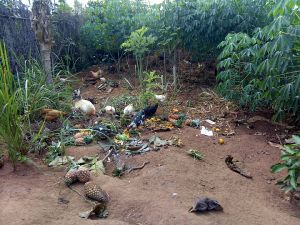
Soil fertility management
- They practice crop association with legumes (cowpeas, peanuts). Some fruit trees are associated with annual crops of beans and other climbing legumes. The trees serve as stakes and the beans fix atmospheric nitrogen in their root nodules.
- Planting of Fabaceae Family Trees (Legumes): Gliricidia sepium. Like annual legumes, this tree fixes atmospheric nitrogen in the nodules of its roots and contributes to soil fertilization. On the farm, they use mulching to protect the soil and reduce weeding actions (the leaves have an allelopathic effect and inhibit the growth of weeds).
- Soil composting by bringing all organic waste to the field (wood ash, urine, dry toilet compost, food scraps). "Depending on what is available, we put it directly in the field. We believe that wild biodiversity also plays a role in fertilization."
The preservation and maintenance of biodiversity is important on the farm. A wildlife inventory has been conducted:
Pest management
Main pests are caterpillars and rodents on cereal crops and tubers, and grain-eating birds (weaver birds).
- Rodent control methods: Constructing sound scarecrows, which are structures with bottles that clink together. The sound scarecrow works well, although its effectiveness tends to decrease over time. Any noise-making device that catches the wind (CD-ROMs, empty bottles, cassette reels, bird-shaped scarecrows to cast a raptor-like shadow) needs to be moved periodically, otherwise, the pests get used to it.
They do not always know the specific rodent species affecting the crops, but these include the Gambian rat, bush mouse, and several squirrel species. They are considering hunting to consume the wildlife and reduce pest pressure.
- Against grain-eating birds: Constructing raptors made of sheet metal and suspending them in trees with a piece of wood.
- Against birds and rodents: Installing human-shaped scarecrows. This technique is less effective as it is immobile, so they need to be moved regularly.
Soil work
Soil work on the farm is very limited. They work the soil in mounds for maize and yam. When they notice that the soil is poor underneath, they may do a surface till to incorporate organic matter and facilitate its decomposition.
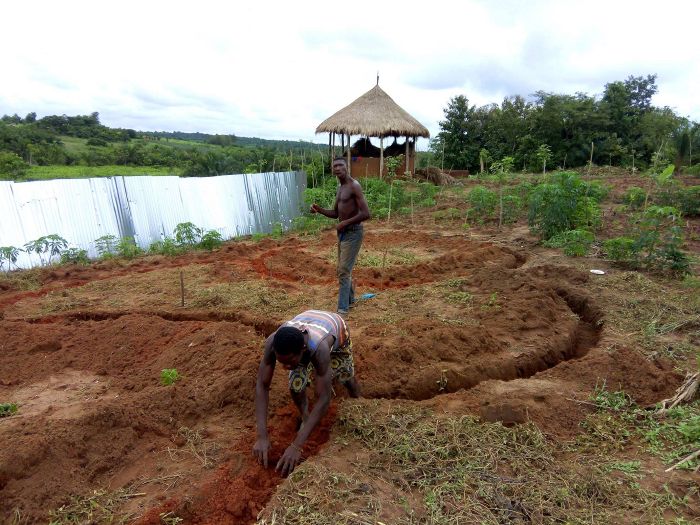
Strategy for constraints
- Mobile network access: There was no mobile phone network access until recently.
- Electricity access: The remote location of the land means that access to the electricity grid is not possible, requiring self-sufficiency in electricity. However, since irrigation is manual, the farm's electricity needs are low.
- Land size and price (6 million FCFA/ha): Anticipated purchases, knowing the owner to buy the land before it is publicly put on sale, and buying land in small pieces to avoid large investments.
- Presence of Malian ants (army ants): These ants put heavy pressure on crops due to their frequent visits. No effective biological control method has yet been found on the farm.
- Predators threatening livestock: Pythons and wild cats prey on poultry. The main breeding turkey was eaten this year. They purchased a camera trap to identify the animal attacking the poultry (probably a Ceba python or a crocodile). They conduct inventories on the fauna and flora (20 snakes have been identified, some of which are large enough to eat poultry).
- Water erosion: This can cause the collapse of some steep agricultural areas. In areas of the farm with slopes, the strategy is to promote a very strong, multi-layered root system to retain the soil deeply.
- Hedge planting: They plant hedges (Pride of China, acacia, fruit trees, annual vines such as passion fruit, plus everything that grows naturally through assisted natural regeneration) on old property boundaries, plus a herbaceous layer that they let establish spontaneously to limit erosion and improve water infiltration. Additionally, they plant herbaceous cover crops in a half-moon pattern: Panicum C1, vetiver, parrot flower (an ornamental plant that multiplies and is used as forage for livestock).
- Small walls: These are placed in some areas to slow down erosion. The technique of rock placement is complicated in the region due to the lack of rocks; they recovered rocks from an adjacent road construction site.
- Organic matter: Organic matter is expensive and hard to find locally because the existing crops are mainly imported and chemically fertilized (such as pineapples). The strategy is to be self-sufficient on the farm by producing a large quantity of organic matter (animal, tree leaves, straw). Many areas are intentionally left fallow to collect foliage or benefit from tree litter to plant more demanding plants like maize, for example.
Water system
- Irrigation outside of the rainy season (November - April)
- Borehole with a thermal pump: A generator fills a water tower. It is used to water green spaces and mainly for domestic use. Water from lowlands (marshes) is used for irrigating cultivated areas.
- Irrigation method: Some plots are watered during the dry season, but this is limited to market gardening and young trees.
- Watering frequency: Irrigation heavily depends on the time of year. It is reduced during the rainy season (April-October). In the dry season, they water the garden twice a day (with water from ponds) and young fruit trees every 3-4 days.
- They aim to switch to a solar installation for the borehole now that affordable, high-quality equipment is available.
Social aspect
Satisfaction / Dissatisfaction
- Workload: 5. 120 hours per week, including all labor. The complexity of the agro-system generates a lot of work. Hosting visitors at the farm adds an additional burden. Since the visit has a free pricing policy, deciding on charges is not always straightforward. They are not "afraid" of the work itself, but they have many questions about the workload because they want to create a reproducible model for a family of 5-6 people. These are questions they constantly ask themselves.
- Economic: 5. They consider themselves still in a development phase and have given themselves 5 years to test the agro-system. The further they progress, the more productive they will become, and they will be able to sell surplus produce on the market.
- Social: 7. Workers live on-site but lead separate lives from their employers.
- Work comfort: 5. Damien gives a "privileged" viewpoint (according to his terms) because he is the boss. The on-site housing was already available, but he believes he could offer "better" accommodation for the workers.
- Living environment: 8.
Scale of 1 = very dissatisfied, to 10 = very satisfied.
Environment
Technical Support
Initially, Damien was trained in market gardening by his mother. Today, Damien and Sathurnin provide support to other farmers.
Cooperation with Other Farmers
They exchange a lot with other farmers, mainly regarding production methods. With neighboring farmers, they barter or donate seeds. Many discussions are underway to implement a peasant solidarity system, which would help others in case of disaster, lend equipment, etc.
Economic aspect
- Land: 5 million FCFA.
- Equipment: Multipurpose press and centrifuge: 100,000 FCFA (150 €), solar panel and battery.
- Donations, financial aid: None.
- Expenses: Very few expenses, mainly equipment and labor.
- Salary: 54,460 FCFA/month in the case of Sathurnin.
Commercial Strategy / Outlets
- Self-consumption before sale.
- Honey is sold locally, while the rest of the production feeds the farm. They currently harvest 40 L per year, which is minimal for the size of the apiary. They had to scale back traditional beekeeping and shift to stingless melipona bees after a fatal worker attack. They consume part of the honey and transform the rest into mead.
- They mainly practice subsistence farming and aim for food self-sufficiency. Any surplus production is sold at the local market.
- An economic evaluation of everything consumed on the farm is conducted so they can understand its potential revenue.
Advice from the Farmer
- Damien: "It is important to question the values we assign to agriculture. Behind every consumption choice lies a political decision. Farmers are asked to put in a lot of effort, yet their jobs are very poorly remunerated. There is no support, no subsidy, to encourage farmers to use agroecological techniques."
- Sathurnin:
- "It is crucial to encourage respect for the environment. It is important to monitor plant health because it impacts human health. Our health depends on what we eat; we must eat healthily to live better.
- Do not focus on a single crop, preserving biodiversity for future generations is essential to promoting food sovereignty and resilience among crops.
- Do not underestimate the role of biodiversity, which is not well known but is important in pest control. For example, do not kill snakes."
Photo gallery
Sources
Interview with Damien Martin and Sathurnin Bossou conducted in June 2024 by the team of Ver de Terre Production as part of the Urbane project.
Photo credits: Damien Martin and Sathurnin Bossou.
This page was written in partnership with the Urbane project and with the financial support of the European Union.

